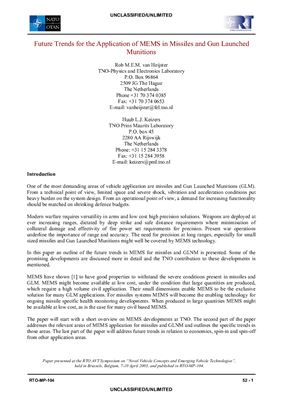(Хайстер ван Роб, Кайзерс Хуб Л. Перспективы применения
микроэлектромеханических систем в ракетах и боеприпасах ствольной и
реактивной артиллерии).
Hague, The Netherlands: TNO-Physics and Electronics Laboratory. –
35 p.
One of the most demanding areas of vehicle application are missiles
and Gun Launched Munitions (GLM). From a technical point of view,
limited space and severe shock, vibration and acceleration
conditions put heavy burden on the system design. From an
operational point of view, a demand for increasing functionality
should be matched on shrinking defence budgets.
Mode warfare requires versatility in arms and low cost high precision solutions. Weapons are deployed at ever increasing ranges, dictated by deep strike and safe distance requirements where minimisation of collateral damage and effectivity of fire power set requirements for precision. Present war operations underline the importance of range and accuracy. The need for precision at long ranges, especially for small sized missiles and Gun Launched Munitions might well be covered by MEMS technology.
In this paper an outline of the future trends in MEMS for missiles and GLNM is presented. Some of the promising developments are discussed more in detail and the TNO contribution to these developments is mentioned. Contents:
Introduction
MEMS development at TNO
MEMS in Missiles and GLNM
Future trends
Conclusive remarks
References
Mode warfare requires versatility in arms and low cost high precision solutions. Weapons are deployed at ever increasing ranges, dictated by deep strike and safe distance requirements where minimisation of collateral damage and effectivity of fire power set requirements for precision. Present war operations underline the importance of range and accuracy. The need for precision at long ranges, especially for small sized missiles and Gun Launched Munitions might well be covered by MEMS technology.
In this paper an outline of the future trends in MEMS for missiles and GLNM is presented. Some of the promising developments are discussed more in detail and the TNO contribution to these developments is mentioned. Contents:
Introduction
MEMS development at TNO
MEMS in Missiles and GLNM
Future trends
Conclusive remarks
References

